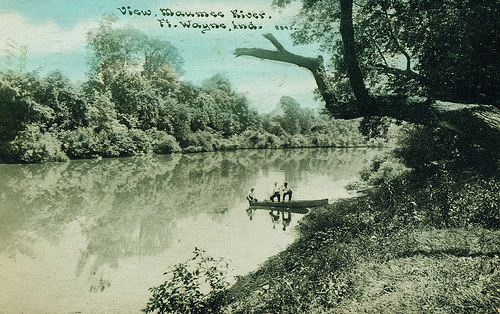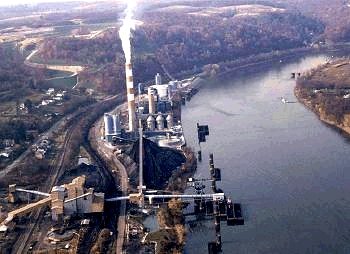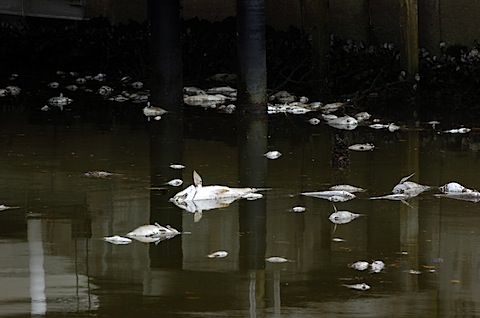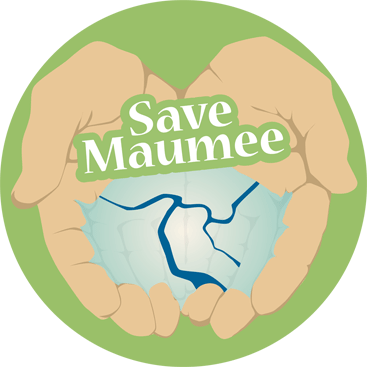Celebrate River Lovers! LOOK what you have done for our 5th Annual Earth Day 2010 on the Maumee River!
The benthos community thanks you!
TOTAL TRASH REMOVED FROM OUR WATERWAYS TO DATE: 8.5 TONS!!!!
TRULY, THANK YOU! This work could not be accomplished without YOU!
Sunday April 18th, 2010 we had 267 official count of volunteers that worked so hard! EVERYONE who works for Save Maumee Grassroots Organization and your rivers, do not receive any compensation of any kind. 100% of donations go to the expensive restoration technique materials.
YOU planted 3 acres worth of native riparian DNR approved seed underneath 1,000 sq ft. of erosion control mats and other barren areas to reduce erosion/sedimentation.
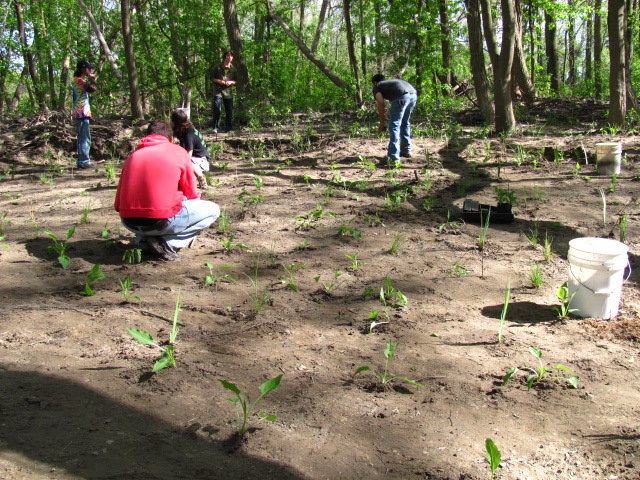
TREE PLANTING RECORD THIS YEAR! – 60 River Birch, 40 Burr Oak, 50 Red Oak, 20 Pin Oak, 20 Swamp Oak and over 1,000 Weeping Willow Poles and Corkscrew Willow Poles! Total tree count for this one day: 1,090 TREES
This Earth Day brings the total to just fewer than 2,000 trees planted on your waterways!
YOU planted over 300 native plant plugs (previously started seedlings)! These retain deep tap roots that hold them in place when the area floods. (after 5 years of growth) ALL these hearty plants are able to live through drought or flood due to their deep tap roots and are ideal for our riverbanks
it is even improving the areas plant diversity!
Our luxury item was planting 60 Raspberry Bushes & 8 Blackberry bushes
Fruit and berries on our rivers are disappearing for 3 reasons;
#1 They are understory trees/bushes and need wet/shady conditions to thrive. (Raspberries like sun so they were placed appropriately)
#2 Most of the forested corridors along the riverbanks in Allen County have been removed, which would provide the canopy for these trees to grow.
#3. Rip Rap (large stones placed on both sides of the river and all foliage removed) to help with flooding issues downtown, but this causes the river water to run very fast downstream, pulling out all foliage on the stream banks because of the flashiness (water rising and receding very quickly.) It makes it difficult for diversity to thrive.
Another Fun Fact: According to Forest Policy Research Org., 2008 Trees can intercept and hold around 2 2.5 millimeters of rainwater- even a modest size rain event in which 10mm of rain might fall, that is still one-quarter of the rain. Water that reached the soil below the tree is returned to the atmosphere over a period of several days. And thus has a significantly different impact on the timeline of future rain events. So studies have shown that land-atmosphere interactions play a significant role in future climate projections; in addition to helping to prevent erosion that leads to suspended sediment that chokes flora and fauna in your waterways. Keep the trees and dirt in their place.
UPDATE to plantings: The trees, poles and plant plugs were under water for 1 week that began 4/27/10
still waiting to see the water recede from the rain-storms on 5/21/10 and today is 5/30/10!
A Girl Scout Troop from Fort Wayne planted 15 flats of plants and about 20 trees Saturday May 29th on the St. Marys River by the Old Fort where some erosion is occurring. These pre-grown plants are from OUR greenhouse that werent big enough to plant for Earth Day Thank you to Julie BurkholderTutwiler!
Special THANK YOU from Save Maumee to the following people who helped bring all of us together this year! Our events are FREE but ALL donations go to projects like this one! Give till it hurts OUCH! The list is getting pretty long but unity and gratitude are so important to share!
*Forester Tom Crow & Allen County Soil & Water Conservation District
*Soaring Hawk Raptor Rehab Great Owl, Horned Owl, Short-Eared Owl, Red-Tailed Hawk demo.
*Home Depot
*Top Notch Tree Service
*Heartland Restoration /Earth Source, Huntertown
*Lyle McDermont – rain barrel demo
*Partnership for Water Quality
*Local ACEs Hardware
*City of Fort Wayne
*Fox Island
*New Haven and Fort Wayne Parks Department
*Old Crown Coffee on N. Anthony
*Health Food Shoppe on N. Anthony
*Camp Potowatamie
*Citizens Action Coalition
*Save Maumee Grassroots Org
*Bike Depot, ACRES Land Trust, USA Air Force REUSABLE water bottles
*Halls Triangle Park
*American Rivers
*Sports & Spirits
*City Utilities Solid Waste Dept-
*Allen County Public Library Downtown
*The Brass Rail
*The Grateful Groove
*Andy’s Horse Tours and Rentals
*Grateful Productions
*The Wilderness
*Anthony Garr
*I CAN
*Our Healing Waters
*Wild Birds Unlimited
* www.indianacomputerservice.com
*Red Lobster
*Wild Birds Unlimited
*Davis King, Jain Young, David Green, Indiana Computer Service
*Lydia Savitz – Port-A-Jon donation – NICE
*Grace Strahm, Ryan Bailey, Melanie McKinnley, Canaan Eubank, Ellen Lay, Peggy Rader, Jen Hancock, Dave Eberhardt, Greg Konger, Beverly Hume, Craig Thorn, Michelle Ferguson, Jennifer Fletcher, Mary Brady & Derek Dailey
*Heartland Communities Inc. 501 ©(3) – Gracious Fiscal Sponsorship for tax deductible contributions
AND ALL OUR FRIENDS AND FAMILY WHO HELP EVERYDAY AS VOLUNTEERS – THANKS and if we forgot to include you DOUBLE THANK YOU! The heart of grassroots belongs to people who donate time or supplies or BOTH!
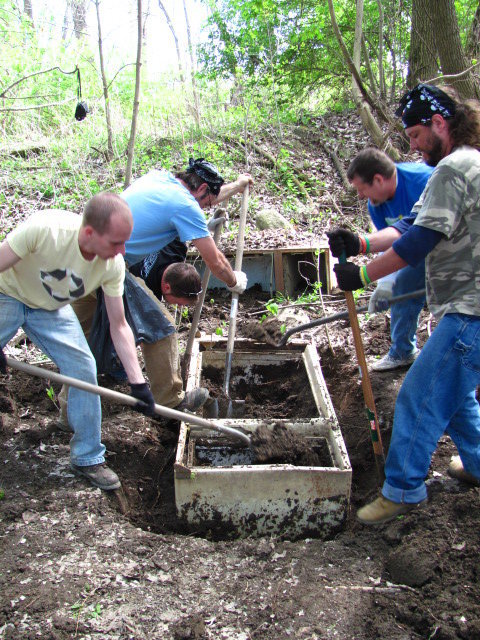
Interesting things we PULLED OUT or WORKER: Award Winners
Largest Trash REMOVED FULL SIZED of the following
water heater, old steel manual plow, a car seat, 2 refrigerators, a furnace, a stove, 12 tires, 85 oz can of oil, 25ft. of a gas pipe, 15 ft. of unknown pipe, rugs and a car trailerhitch.
It took Senatorial Candidate (15th District) Jack Morris, Bryce Gustafson, Brian Foster, Wade, Marissa Jones, Greg Morricle, Sandman, Josh Jackson, Rickey Fuller, Harold Wallen, Peter Kauffman, Evan Hill and the guy in the blue shirt! The guys took the scrap in for recycling the next day! SWEAT EQUITY!
Coolest Find – Morrell Mushrooms were found ssshhhh its a secret where they grow!
Most Contaminated Trash An 85 oz full can of oil found by local artist Rickey Fuller
along with all the kitchen appliances!
Largest Unified Group Phi Theta Kappa Honors Society from Purdue University
Funniest Trash A red high healed pair of shoes found by Brenden Sears (8) Kerian Ward (11) and Elyssa Fuller (11)
Most potential to contain West Nile 12 tires
Most berry bushes planted Winner: Bruce Allen planted all the raspberry bushes and also represented the Maumee River (and northeast Indiana) in Washington D.C. this year thanks to Healing-Our-Waters!
Got the most children involved: Gary & Nicole Jeffery
Most Fauna Love – Preston Arbuckle hung a Wrens Nest on the Maumee Riverbanks – from Wild Birds Unlimited
Most Interesting – Ashleys family brought us some old railroad lights (covers?) pulled out of the Maumee and they were given to Ellen Lay for art creation!
Celia Garza got the names for the thank you for all of our hard workers (FOR HOURS and HOURS) down on the erosion control project and I never got them!!! BOO! THANK YOU HARD WORKERS!
Total Miles of northern AND southern streambank cleansed 1.5 miles – including The Ravine self-dug bike trail which is considered one of the top 10 self-dug bike trails in the USA.
Most FUN: Andys Horse Tours and Rentals had 6 horses and a miniature pony to take you for rides on the greenway! NICE! Their volunteers also painted faces!
Most Educational
Soaring Hawk brought a Short Eared Owl & Red Tailed Hawk and spoke about their habitat on the riverbanks What beautiful animals!
Most Home-Useful – Rain Barrel Demonstration by Lyle McDermott to show us how to capture water and release during drier periods
great idea for watering a raingarden, food garden, or your flowers!
Jain Young Herb Specialist took volunteers on an Edible Herb Walk to show what you are missing on your plate at home native home grown food grown right here!
Grace Strahm – demonstrated what a watershed IS and how YOU affect it with an enviroscape demonstration.
Of course we needed something to keep yall lively
.
* Health Food Shoppe Snacks
* Coffee from Old Crown Coffee Roasters
* REUSABLE water bottles from ACRES Land Trust & U.S. Air Force
Oh Yeah ~ Quit buying water bottles that you use only once and throw away ~ STOP IT ~ Plastic is made from petroleum based products and is a long story. Please consider watching TAPPED or FLOW documentaries on your water and the exploitation that is happening We gave out 300 water bottles donated by the U.S. Air Force and ACRES Land Trust to volunteers!
~ Save Maumee always supporting Local & Live Entertainment at our events~
*The Wilderness BACK for the threepete! 3X have we’ve enjoyed these guys!
*Anthony Garr
*Grateful Productions ran the PA
PBS, FRONTLINE Poisoned Waters an extremely informative program to help you understand non-point source affects that face watersheds today in the USA.
http://www.pbs.org/wgbh/pages/frontline/poisonedwaters/
Indiana needs an Upper-Maumee Watershed Management Plan for our State! The Upper Maumee Watershed Partnership is working toward hiring a watershed coordinator and then the plan will begin to form. A watershed management plan is simply a list of priorities and measurable steps that will be taken toward improvement. The Maumee is considered a low priority stream because it crosses political boundaries; City of Ft. Wayne, Allen County and State of Indiana
downstream seems to be somebody elses problem? Historically it has been surrounded by industry, landfills, CSOs, brownfields and a Super-Fund Site. We are asking for people who have a skill that are interested in participating in a steering committee group to address 11 situations with proposed solutions. Biologist, teacher, lawyer, accountant, writers, scientists, surveyor, doctor, zoning experts or dedicated citizens NEED to apply! We truly want to help improve our water and it will take us all. www.uppermaumeewatershed.com
==================================
Upcoming Event Calendar: YOU are NOT Powerless! ~ Voice visions & values more often and more loudly – SHOW UP for a meeting or an event in 2010!
————————————————
THIS TUESDAY June 1st 7:30AM 8:30AM YES IN THE MORNING BP Protest at Fort Wayne BP Gas Station on Jefferson Blvd. & Fairfield
Want BP to clean up their mess NOW? It is effecting our food supply, they were outside of legal parameters for drilling, problems were present up to 6 weeks before the explosion
.so show up and tell BP how you feel about the largest oil spill that affects us, our children, our oceans, our beaches, our fresh water & inlets, our land, our resources, our money, our animals, our air, and our plant life.
Watch this
BP DID know problems existed previous to the spill http://consequence09.org/2010/05/gripping-60-minutes-piece-on-gulf-oil-spill/
See yourself working at Save Maumees 5th Annual Earth Day 2010 on Fort Wayne Public Access:
COMCAST channel 55 OR 57 VERIZON channel 25 OR 27
June 3, – at 8PM
June 6, – at 8PM
June 10 at NOON
June 15 at 6PM
June 16 at 10AM
Save Maumee’s Canoe Clean-Up, Can YOU Clean-Up Saturday September 18th 11AM 4PM FORT WAYNE OUTFITTERS & BIKE DEPOT LOCATION – Cass Street behind The Bean – Free canoe rental for participants for the day with a photo I.D.! It will be too late in the season for plantings
but never too late in the season for garbage removal and free paddling! Free Canoes with I.D. from Earth Adventure on Main Street & Ft. Wayne Outfitters first come, first serve (the website says Sept 4th but needs an update!)
Save Maumee Seed Harvest at Fox Island: – Saturday October 2nd OR 24th 1 PM 4PM at Fox Island (date may change due to harvesting availability and best pickin date)
June 5, 2010 Help Walk for the Wetlands : Saturday from 9:00am to 11:00am www.lrwp.org
June 10, 2010 see National Serv-Alls Conservation Efforts from 8:00am to 10:00am at Eagle Marsh
June 26, 2010 – Riverfest on the banks of the St. Joe at IPFW – check it out! Fun includes a zip-line, hot air balloon ride, fireworks, live entertainment rivers, live local music. Come & Celebrate the positive things about our rivers! – Steele Dynamics Inc. is title sponsor for RiverFest, sitting at the table with Save Maumee shows their dedication to transparency and best management practice to improve the health and wealth of our rivers! http://ipfwriverfest.org/
July 24th – Upper Maumee Large Scale Clean-Up from Fort Wayne, Indiana to Defiance, Ohio – be part of the canoe fun! Still in the works – mark your calendar! Different launching spots with exit areas downstream and a ride back to your car! Currently we have secured places for launching in Fort Wayne & Defiance, OH! More to come on this! Email for reservations: abby@savemaumee.org
September 4th – Maumee Bay Tour – take a bus to Toledo, Ohio’s Maumee Bay and find out about the sediment load being deposited and removed from your waterways – call Jason Roehrig for interest or reservations (419) 782-8751
September 25th – Scenic River Canoe Tour and Water Monitoring in Antwerp, OH – Call Jason Roehrig for details or reservations (419) 782-8751
The river thanks you from its bottom! Invest in Natural Capital!
Map for areas of concern…you can see the google map here and would
love your feedback/comments or your pictures :http://tinyurl.com/c3fm9v
email: savemaumee@yahoo.com
http://www.myspace.com/savemaumee – MySpace Save Maumee
Twitter user name: savemaumee www.myspace.com/savemaumee
A Greener Indiana http://www.agreenerindiana.com/profile/AbigailFrost
Facebook: Abigail Frost Save Maumee
Please help us to speak for your rivers
for your rivers have no voice! You spoke loud and clear on Earth Day and we ALL thank you for that!
Sincerely,
A. Frost-King
Save Maumee Grassroots Organization Founder
Master Naturalist
Watershed Expert
http://www.savemaumee.org/
100% donations from you go only to best management practices for naturalization of riparian areas – this is what grassroots organizing is all about! ALL VOLUNTEERS~ All money came from Grateful Groove Fundraiser, Alysen Wade Lexicon Event, The Wilderness Band Fundraiser, Earth Day 2009, Canoe Clean-Up 2009, Sports & Spirits Bar & Grill and raised a whopping $27 dollars at the FREE event! Namnaste to many small monetary donors! Save Maumee did not raise as much money as last year but we are very proud to supply you with these effective erosion control techniques for OUR riverbanks!
Published: April 19, 2010 3:00 a.m.
Trash-busters scour up Maumee
Devon Haynie
The Journal Gazette

Photos by Samuel Hoffman|The Journal
Bruce Allen plants raspberry bushes for erosion control on Sunday as part of Save Maumees fifth annual Earth Day celebration to help clean up the river.

Brenden Sears, 8, left, and Keiran Ward, 11, collect trash in the Maumee River on Sunday.
It was a little bit like a scavenger hunt along the Maumee River on Sunday, although clues were often bad smells and nobody wanted to touch what they found.
Sunday marked Save Maumees fifth annual Earth Day celebration near North Anthony Boulevard and Niagara Drive. About 100 volunteers gathered this year to plant seeds and pull objects they could from the muddy river.
This year I pulled out a gas tank, Abigail Frost, the event organizer, said as she stood on the banks of the river near a pile of trash. This here is a trailer hitch. And this (she pointed to two metal poles)
I have no idea what this is.
Frost started Save Maumee five years ago to get the community involved in keeping the river clean. She said she didnt think much about Fort Waynes rivers until 2000 when she moved near the Maumee.
She was about to let her kids swim in the river when friends warned against it. Curious about how polluted it was, Frost started doing research. What she learned appalled her the water was tainted by sewage, manure and dangerous chemicals.
By 2005, I couldnt shut my mouth anymore, she said. I had to take action.
When Frost first started her Earth Day activities, she used her own money to pay for seeds to plant along the shore. Today, she depends on proceeds from T-shirt sales and horse rides throughout the day. She also accepts seed donations from people and the Little River Wetlands.
In the past, Frost and her volunteers have found computers, cell phones and plastic pink flamingos in the river. This year, volunteers also spotted a refrigerator.
Elyssa Fuller, 11, said although she absolutely hated cleaning her room, she enjoyed picking up the river.
When people litter, its ruining the environment, she said. Thats why you come out here and put your time into picking up the river. It helps make the world a better place.
dhaynie@jg.net






